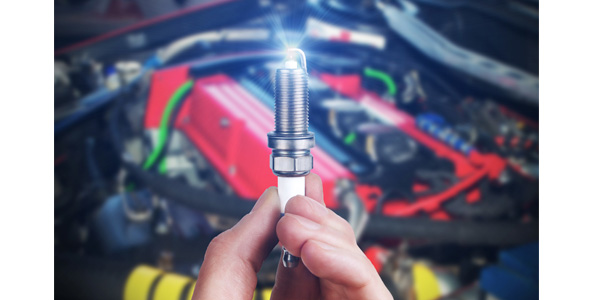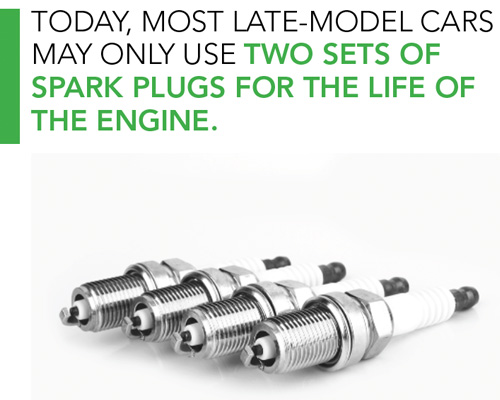
A spark plug can ignite at 400 times a second, per cylinder, and is one of the hardest-working parts in the engine. Vehicle owners often neglect these small, wiry wonders because of advancements in the design of not only the plug itself but also the components that run them.
The first spark plugs were handmade and had a porcelain insulator that was molded on a potter’s wheel until geologist and mineralogist Helen Blair Barlett, who was interested in spark plugs, invented the ceramic insulator. The problem with porcelain (besides being handmade) was that they tended to break easily. These early spark plugs also required frequent maintenance to clean and gap them about every 50 miles.
Today, most late-model cars may only use two sets of spark plugs for the life of the engine. Long-life platinum and iridium spark plugs are typically good for around 100,000 miles or more under normal operating conditions. Standard copper plugs are not as durable and need to be replaced between 35,000 to 50,000 miles.
Despite the widespread use of precious-metal plugs, copper plugs aren’t obsolete yet. Many racers prefer the low cost and wide variety of heat ranges offered. Customers with small engines and vintage cars may also use traditional plugs, which still make up a good portion of ignition sales. Just remember, there are other uses for standard copper plugs besides customers shopping for the lowest price.
Your local racing customers may ask for standard copper plugs because they’re reliable and inexpensive compared to precious-metal plugs. Most racers analyze and change their plugs frequently, so the advantage of an extended service interval isn’t essential to this customer. And, changing an $80 set of plugs every few weeks can be a budget-buster for many grassroots racers.
Plug wear results when the gap between the center and side electrodes widens and increases the voltage required to create a spark when the plug fires. Eventually, the voltage necessary to fire the plug exceeds the output capacity of the coil, and the plug fails to fire at all. Plug wear and overheating from high firing voltage also can damage the ignition coil, especially on coil-on-plug (COP) ignition systems. The boot on the COP coil may get so hot that it melts! With OBD II vehicles (1996 and newer), a diagnostic trouble code light is set off whenever the ECU detects there’s a misfiring spark plug. In most states, an illuminated “Check Engine” light means that it won’t pass inspection.
You always should replace spark plugs in sets for the best performance (unless you’re replacing a newer plug that has a broken electrode or cracked insulator). While all spark plugs come pre-gapped from the manufacturer, it’s a good practice to recheck the gap with a feeler gauge. Do not use a slide gap tool; it can damage the plug.

You can use a dab of anti-seize on the threads, but use caution, so you don’t get any of it on the electrode or the tip. Too much lubricant/anti-seize also can increase the torque value beyond the recommended limit. Tightening the plugs too much into aluminum cylinder heads can cause the threads to strip, since the steel threads on the plug are harder than the aluminum.
You also may have to remove plastic covers and ignition coils (COP) before you can get to the plugs. Use a ratchet with a long extension and an insulated spark plug socket to ensure the plugs come out quickly. However, some plugs can be tough to remove if the threads are corroded into the aluminum head (e.g., Ford 5.4-liter V-8s).
Make sure you allow the engine to cool before removing spark plugs, and mark the plug wires (if they have them) to identify cylinder positions. If there is any debris in the plug wells, blow out with an air hose or a can of brake clean with a rag over the top before removing the plugs. Do not overtighten the new spark plugs. Tighten until the crush washer fully compresses, but not much more. Your customers may not change their vehicle’s spark plugs, but if they do, it’s important to know the proper steps. It’s always good to recommend long-life plugs for older cars, but not the other way around.












